VIDEO FEATURE & WEB-EXCLUSIVE INTERVIEW
Musician: AUSTIN CHURCH
Video: “MISS OLA (THE MISSISSIPPI GIVER)”
Musicians: Austin Church—lead vocal
Davis Causey—rhythm guitar, bass, dobro, hand claps, tambourine
Gerry Hansen—drums
Randall Bramblett—piano
Rosa Thurmond & Greg Hull—backing vocals
Director: Ralph Clemente
For over four decades, Austin Church has been creating his unique brand of music that flows from his heart. He’s a singer songwriter with “an unorthodox turn of phrase and a touch of whimsy—bolstered by an underpinning of hope.” Born Vernon Marshall Arnold in Hartford, Connecticut on August 28, 1946, he traveled a lot when he was young because his father was in the Airforce. After spending years in the southern states, he says “I’m really a Southern boy at heart.” The “Churchman,” as he is affectionately known, continues to craft his songs in hopes of making people smile while inspiring them.
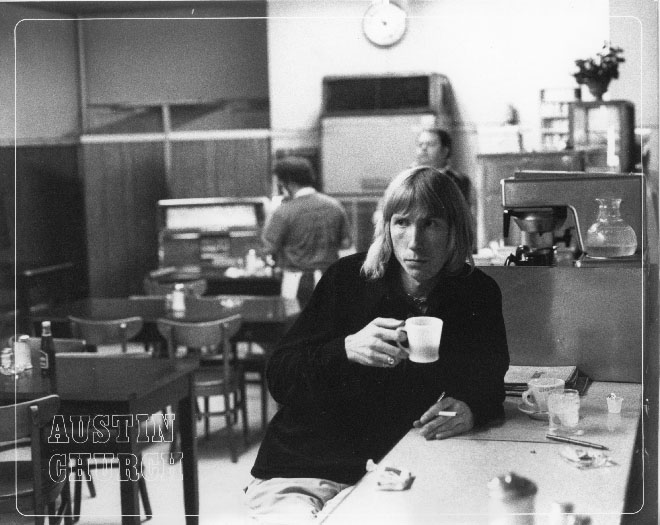
Photo Credit Dean Wilson
As a regular performer at the Athens, Georgia, folk and blues club “The Last Resort,” Church met many musicians who became good friends—Townes Van Zandt, Gamble Rogers and Jimmy Buffett, with whom he wrote “Brand New Country Star,” which appeared on Buffett’s 1974 album Living and Dying in 3/4 Time.
Church recalls, “Townes and I rode around in a small blue bug—that’s when I first heard ‘Pancho & Lefty.’ Townes enriched my life tremendously—as did so many wonderful musicians who became my friends during that time.” He spent the next 20 years in Nashville crafting songs which included cuts by Del Reeves and Lyle Lovett.
Hard work, and writing practically every day, led to Church’s most meaningful and significant 1999 song—“Miss Ola (The Mississippi Giver)”—celebrating the life of a humble, selfless 91-year old washerwoman named Oseola McCarty who washed and ironed clothes for 75 years. The dollar bills and change that she saved grew to $250,000, and then in 1995, four years before she passed away, she gave $150,000 to endow scholarships for black students hometown University of Southern Mississippi—where tuition at that time was $2,400 a year.
The New York Times article said, “Day after day … she took in bundles of dirty clothes and made them clean and neat for parties she never attended, weddings to which she was never invited, graduations she never saw.” She didn’t have that education opportunity because she quit school in the sixth grade to go to work. She saw it as a blessing because too many other black people in rural Mississippi did not have even that. She never married and never had children. “I wanted to share my wealth with the children,” said Miss Ola, whose only real regret was that she never went back to school.
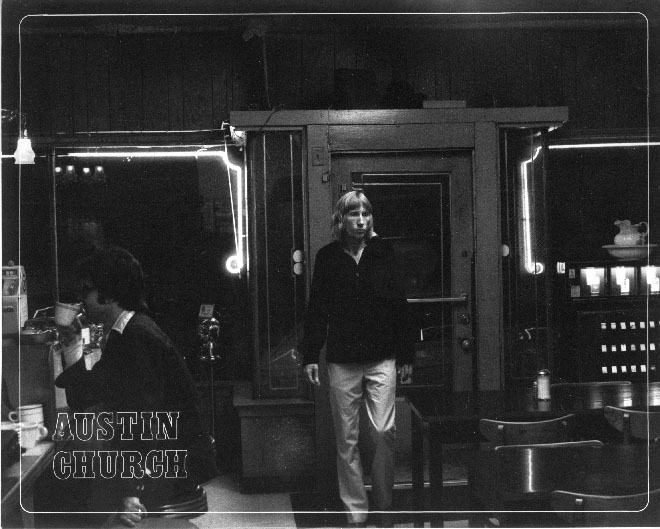
Photo Credit Dean Wilson
When we asked Church why “Miss Ola” means so much to him, he said “Black History Month honors noted African Americans—celebrating their contributions to the American experience. February was chosen to coincide with the birthdays of Abraham Lincoln and Frederick Douglass. Miss Ola’s circumstances denied her the chance for a higher education, so she did what she could do—she washed and ironed clothes for 75 years, and saved a great deal of money which enabled deserving kids to attend college.”
The one thing that makes Church beam with pride is that his song will continue to shine the light on Miss McCarty’s humble and self-sacrificing life—her hard work and ability to save an incredible amount of money, and especially because it provides a spotlight on the value of education.
Church clearly remembers recording “Miss Ola” at Davis Causey’s studio, and having all the wonderful musicians bring his song to life, especially having his friend Randall Bramblett on piano. He was so happy that Ralph Clemente produced and directed the video because he feels “this is a story the world needs right now.”
You can hear the Churchman’s music on any of his four albums: Dreamin’ Backwards (2002), Propitious Mélange (2008), In the Blue Ago (2010) and Walkin’ in Outa Leavin’ (2012).
Austin Church continues to write and record his music, play at music festivals and participate in songwriting events. His honest approach to music is seen in the fact that he is especially proud of his gig next week on February 20, 2017 at 2 PM: “It’s the 15th year in a row performing a special concert at the Cocoa Beach Public Library, where I will surely feature ‘Miss Ola (The Mississippi Giver).’”
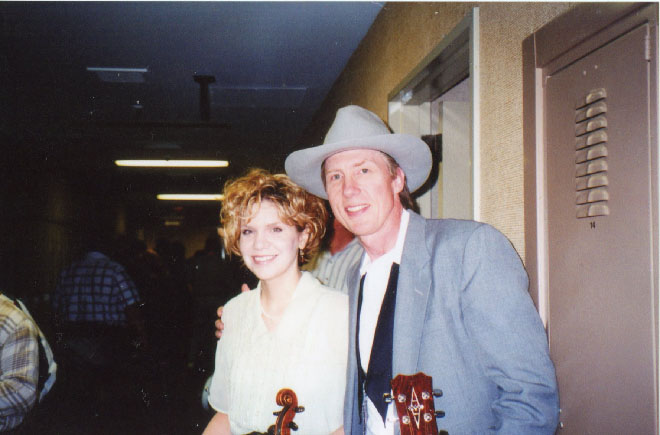
Austin Church with Alison Krauss
AUSTIN CHURCH Web-Exclusive Interview
with M Music & Musicians magazine publisher, Merlin David
How did the idea of “Miss Ola (The Mississippi Giver)” come to you?
In 1999, I saw Miss Ola’s (Oseola McCarty) picture and article in the transition section of Newsweek magazine. The humble, serene, innocent eyes of this washerwoman looked at me, and I thought, here is my paradigm. The rest of the world got swept away. It took me until 2004 to complete the song, but I felt now I’m doing what I should be doing. If I possibly can, I want to get my “read” of this story out to the world. I want to thank y’all at Mmusicmag.com for shining the light back on “Miss Ola.”
What is your creative process for writing songs?
Something occurs, and I feel it’s something I should say—so I’ll write it down in a “Hook Book,” or I’ll just start singing it. Sometimes I’ll fool around with guitar riffs, and it will take shape from there. Other times when I walk, I carry little white cards, the size of business cards. Quite often when I get back, I have a complete song.
How do you keep song ideas fresh?
I keep fresh by staying fast and loose. If you overthink, fret or calculate, you might stiffen up. The words and melodies, I just let ’em rip, and make it an adventure. Like my dad said when I was pitching, “Son, just rare back and fog ’em in there.” New ideas are life—live it.
How has co-writing shaped your music?
When someone sees a scene, it’s different from everyone else. When you co-write, you encounter a different slant. Combine that with your take, and you have a winner.
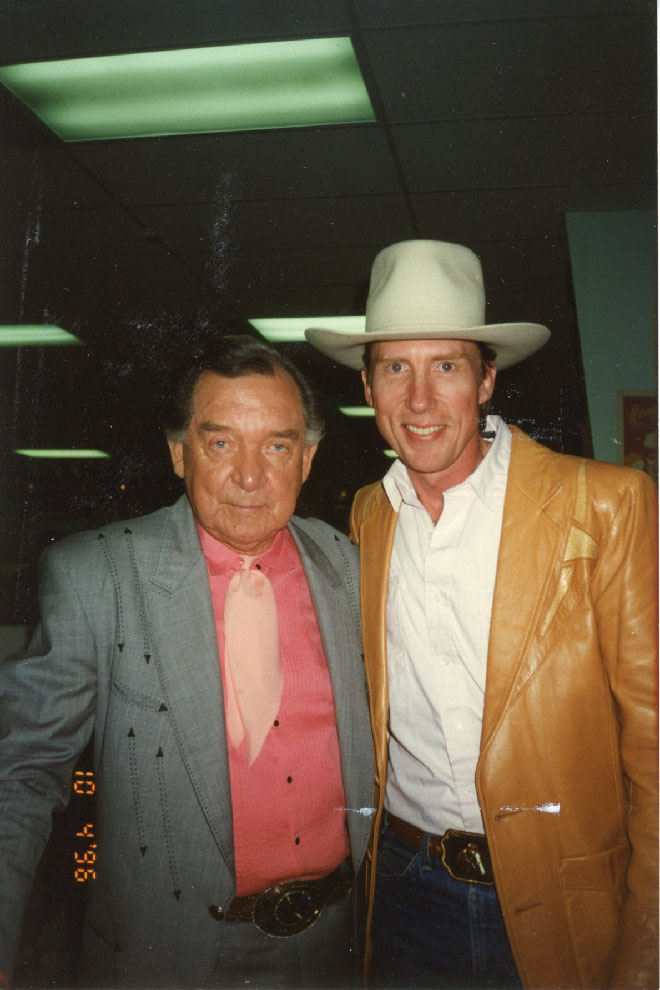
Austin Church with Ray Price
Tell us one experience where something unique inspired you to write a song.
I want to mention two, if I may. After reading about all the guitars Steve Earle pawned, due to a near-fatal addiction, I wrote “Pawn Shop Guitar.” I wanted to give the guitar a say—it’s actually the guitar singing the song. Then there’s a song I haven’t written yet. I met Aaron Jett at Vanderbilt Children’s Hospital, where I sang on Fridays back in 1982. He was the most excited, energetic, wide-eyed boy—he never gave a notion he was fighting with “Luke” [leukemia]. One day he dressed in a Superman suit and ran around the courtyard, cape flying. He flew to heaven shortly thereafter. I’m calling the song “Aaron Jett Can Fly.”
Tell us about writing songs with Jimmy Buffett and other songwriters.
Writing with Jimmy Buffett was a kick. We have one song, “Brand New Country Star.” He sang our song on stage the night we wrote it. Hope there’s another one. I love writing with others. Johnny Christopher, who wrote “You Were Always on My Mind,” was so solid. We wrote “When a High Becomes a Low.” There was Joe Sun, who could reach out there and grab the left field stuff—always fun. And Rich Fagan was a songwriting machine. I’m lucky to have a few with him. Then there’s Brent Moyer—what can I say—a musical champ. And John Carpenter is a new co-writer for me. He brings a lot of theory to the table—great thinker, creative storyteller.
How did Townes Van Zandt influence your music?
The fact that he thought I “had something” took me to a great place in music. He was deep, but he showed me the depths by a captivating trip, then we’d crawl back into the world and fling a song at each other. He’d always try to “get you”—keep you on your toes. He took tongue-in-cheek right past the left molar. He gave me a book of poems by Pablo Neruda. I’m thinking, Townes is a master poet and he digs this guy—this must be the stuff. Thanks, Townes.
What songwriting tip would you like to offer?
This tip is really more for me. You got three minutes—bring it. It’s a cherished space in time. If you throw some words at it, it might not be fulfilling. Pull away from it, like an artist stepping back from a painting. Don’t be afraid to rework it. Ask yourself, “Is it just sounds and words, or does it sing?”
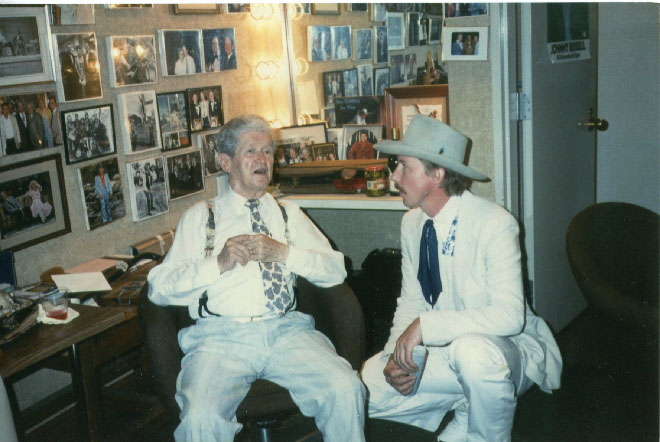
Austin Church with Roy Acuff
Who influenced you to pick up the instruments you now play?
I play guitar, harp, snare drum, and peck, not pick, the piano. When I was a boy of eight or nine, I’d see street musicians with guitars, and was in a state of wonder. The strings would glimmer in the sunshine as they rared back, moaning out a tune. I’d watch a local TV music show as a kid in Montgomery, with Jack Turner out front, and I was fascinated by the guitars, super 400s, flat tops and steels. A guy in a high school band played a Fender Mustang, and that was ultra-cool. Of course, when Elvis came on Ed Sullivan with his Martin D-28—that was it.
Who inspired you to write songs?
I loved poetry in high school English. I started writing poems after school, and everything sprang from there. So I’d say Donne, Keats and the rest of them word slingers.
Where were you the first time you heard one of your songs on the radio?
I basically started my music in Athens, Georgia, in the late 60s, early 70s. In ’75 I went to Nashville for the first time and cut a record with just me and my guitar. The album was called Out of the Rain. I traveled back to Athens, and heard it on the local radio station, and—blastoff. My mind was dancing on sparkling jewels.
Tell us about working with some music legends.
Right after I met Townes in Athens, he had me on stage between his sets. I opened for him in Nashville and Birmingham—incalculable joy and validation. Guy Clark had me record a song in his office studio. I was thrilled. He also had my guitar fixed. (Laughs) I would sing for hours with Jack “Cowboy Clement in his office. I played my Martin and he played dobro. Then we went to a meat and three, came back and sang right into the night. Mentor Williams introduced me to Steve Cropper. I invited Steve to a club where I was playing, and he showed up. I introduced him to the crowd and said, “How ’bout helping us out up here, Steve.” He jumped right up and grabbed a tele and played two numbers with us. Good Lord have mercy! (Laughs) I now live in Florida, and an amazing Florida singer-songwriter, guitar phenom—the departed great Gamble Rogers—inspired me tremendously. He spoke highly of my talent. I was honored to have him as a friend.
Top 5 Musicians or Songwriters who inspired you to become a musician?
Bob Dylan, Hank Williams, Louis Armstrong, Johnny Cash and Glen Miller.
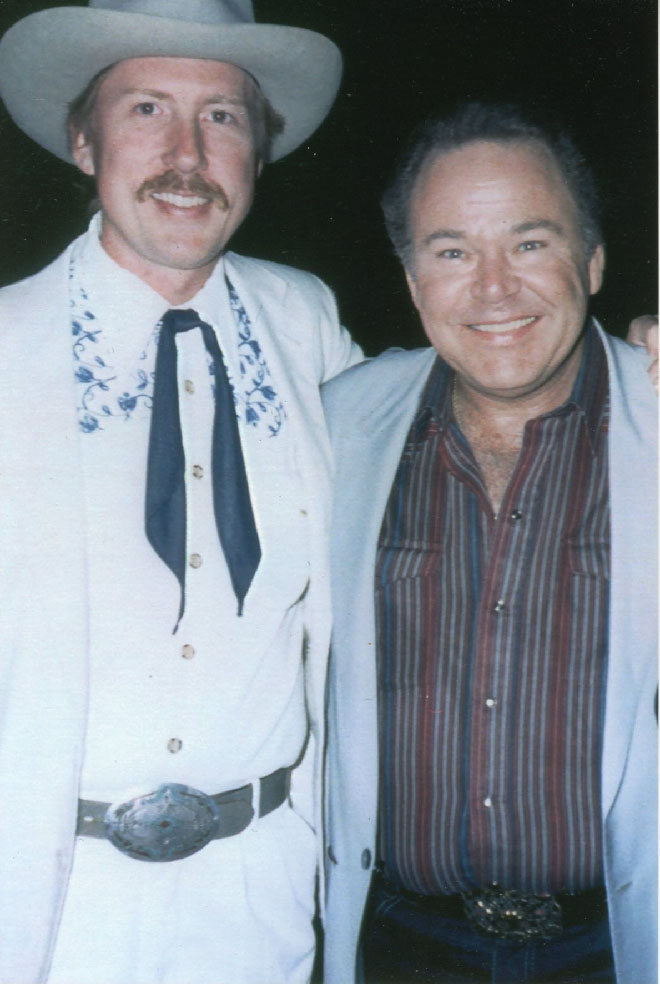
Austin Church with Roy Clark
What instrument can you not live without?
My Martin D-28 guitar and Martin strings. When I’m sleeping, I dream about it. When I wake up, I grab it and we’re gone. It’s a love, craving, passion—I’m in a true zone here.
Any musicians or songwriters you’d love to work with in the future?
Dwight Yoakam, Brad Paisley, Eric Church and Randall Bramblett.
What PRO are you with, and how do they help a songwriter/artist like you?
I am with BMI. They are always there with answers and advice. It’s amazing what they do. I am so thankful for them.
What are your Top 5 favorite albums of all time?
Live at Union Chapel, London, England (2005) – Townes Van Zandt
Lady in Satin (1958) – Billie Holiday – really every album of hers.
Thelonious Himself (1957) – Thelonious Monk – and every album of his too.
Highway 61 Revisited – Bob Dylan
Tammy’s Greatest Hits (1969) – Tammy Wynette

Austin Church with Steve Cropper
Best advice someone has given you.
As a young man tempted by all sorts of mind altering substances, I heard Swedish film director Ingmar Bergman say, “Let your art be the drug.” I took his admonishment to mean: Get a “natural high” off your art. I really inhaled his drift, and eventually got it down to nothing, and I’m higher than I’ve ever been. I hung a sign on my mind saying, “I’m singing here”—and I follow it every day.
Are there words of wisdom you’d like to share with this new generation of musicians?
Be as much a student of musical history as possible—going right back to the drums of the ancients. Like Edison studied Newton, Tiger studied Jack, and John Lennon studied Buddy Holly. Open the receptors. Everything you hear and feel can be interpreted as music and manifest in your work.
What’s next?
I always stay busy. I did a BMI Writers Fest in Captiva Island, Florida back in September. I was then in Nashville with Norwegian star Ottar “Big Hand” Johansen and “Southern” Nilson. The Frank Brown International Songwriters Festival was in November. Doc Ford’s Sanibel/Captiva was January, and on it does. The songwriting tap is full on and I can’t turn it off, nor do I want to. I’m working on a new album, at various studios here in Florida—Swampedge Studio, Titusville; John Carpenter’s Studio, Cocoa Beach; and Barefoot Studio, Sanibel.
Where can your new fans get more info and stay updated?
AustinChurchMusic.com
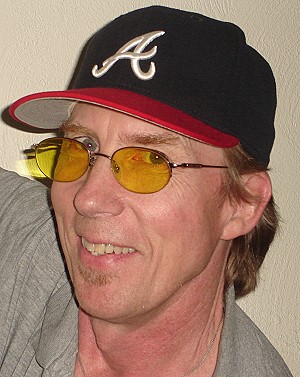



comment closed